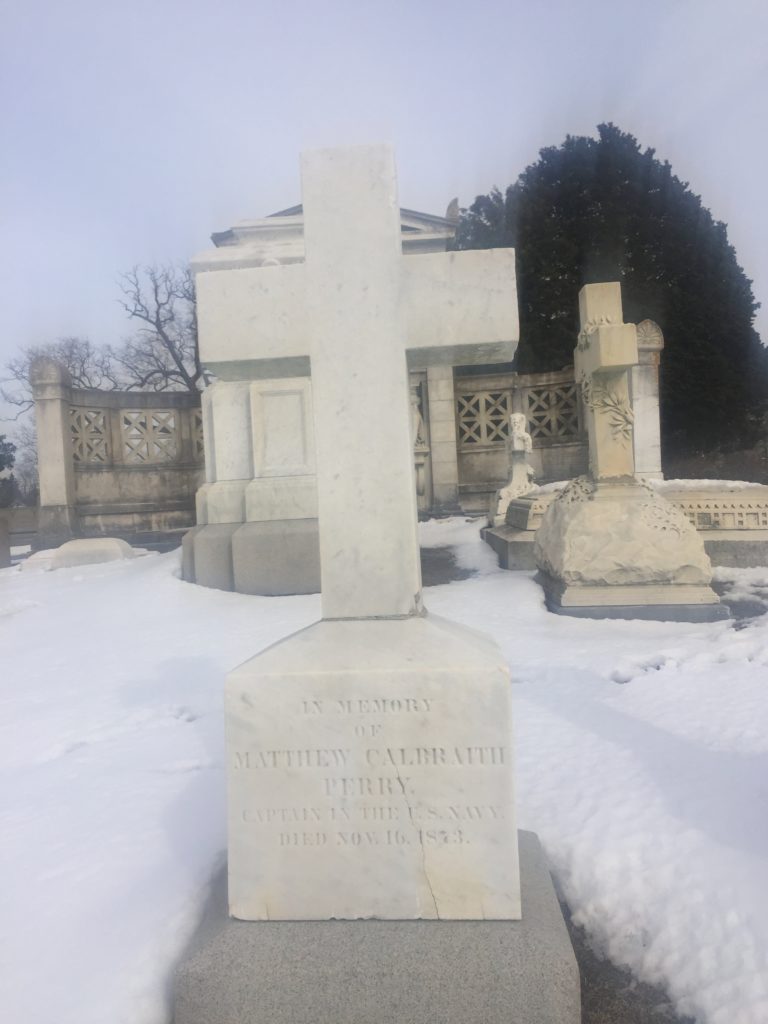Erik Visits an American Grave, Part 587
This is the grave of Matthew Perry.

Born in 1794 in South Kingstown, Rhode Island, Perry grew up in the world of post-Puritan respectability, with many ancestors being leading early Europeans in New England. In 1809, Perry entered the Navy. This made sense, as his father was the naval officer Christopher Raymond Perry and his older brother Oliver Hazard Perry was already making a name for himself. In fact, Oliver was Matthew’s commander on the USS Revenge. He was on the USS President in 1812 when his commander there, John Rodgers, fired the first shot of the War of 1812. He and Rodgers were both wounded by a cannon shot fired in return. That was about it for Perry in the war. He was transferred to a ship based out of New London, Connecticut, but the British had it trapped in the port and there it stayed.
Perry spent the next several years in a variety of missions, including fighting piracy in the West Indies and the Barbary Pirates in the Mediterranean. At one point, the Russian Navy offered him a commission, but he declined. In 1822, Perry sailed to Key West and planted an American flag there, declaring it U.S. territory. The Spanish had declared the Florida Keys part of Cuba and did not include it in the Adams-Onís Treaty of 1819. By 1822 though, everyone pretty much knew it was American and this just made it official. Perry was also a big believer in the nation needing to modernize the Navy and fought hard to get steam ships built. He commanded the second the Navy had, which he had personally supervised the building of, the USS Fulton. He also organize the nation’s first corps of naval engineers. He was named as a commodore in 1840, which was as high a title as anyone could get at this time. He was technically still a captain, which was the Navy’s highest rank until 1857, but the commodore label was a sort of promotion within the rank. Perry then commanded ships in the unjust war to steal half of Mexico to expand slavery; he was in charge of subduing the Gulf coast cities.
What Perry is most known for is his trip to Japan. In 1852, Millard Fillmore sent him to Japan to force that nation to open at the barrel of gun. He reached Edo Bay in July 1853. When the Japanese told him to go the only port open to foreigners–Nagasaki–he refused and told the Japanese he would destroy them if they did not let him pass. Then he engaged in a barrage of blanks, just to show American naval power. He was allowed to land briefly and then went to Hong Kong, promising a return. On the way back, he stopped in Formosa and suggested the American government conquer and claim it due to its coal supplies. The government was not prepared to do that; it certainly would have been a different history in Asia had that happened. Perry then returned to Japan in 1854. He really understood nothing about Japan; not for the last time would the United States stumble into nations that it was fundamentally ignorant about. He forced a treaty to be signed, thinking it was binding. But Perry didn’t even know about the Tokugawa Shogunate in any meaningful way, so it very much was not in force in Japan. But there’s no question that this was a transformative point in Japanese history, when the nation’s elites realized its previous isolationist position in the world was not going to last much longer. A real treaty was worked out in 1858 that changed Japan forever, opening it to foreigners and outside monetary supplies.
Perry returned to the U.S. in 1855, was given a big financial bonus, and then was promoted to rear admiral in 1857. But his last years were not great. See, Perry was a massive drunk and years of boozing were destroying his health. He never officially left the Navy but was unable to serve at the end. He died of rheumatic fever exacerbated by gout and cirrhosis of the liver in 1858.
Yes, I know the grave says he died in 1873. This is some kind of drunken error. Perry was initially buried in New York but in 1873, he was moved to Island Cemetery in Newport, Rhode Island by his widow. Yet the stone says he died in 1873. You’d be amazed how often there are discrepancies on gravestones of famous people.
If you would like this series to visit other American naval officers, you can donate to cover the required expenses here. John Rodgers is in Washington, D.C., and William Halsey is in Arlington. Previous posts in this series are archived here.


